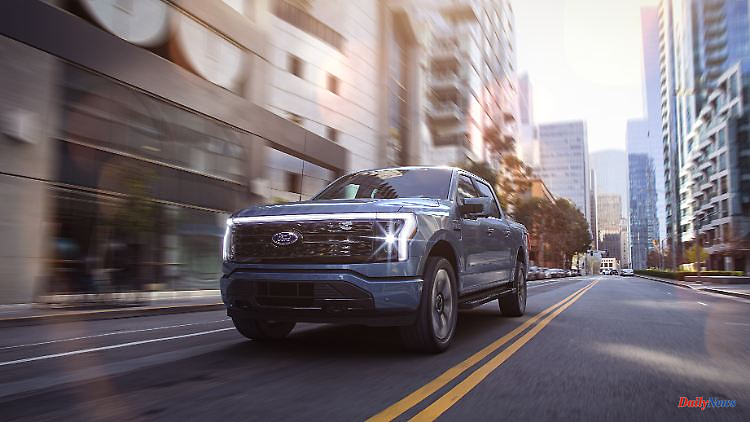The old US car world from Detroit looked shabby for many years and was the loser in the race against Tesla and Co. But now Motown is back - and is catching up with billions of investments.
Derelict factories, burnt-out houses, deserted streets and even downtown after closing time disturbing darkness - anyone who walked through Detroit five years ago had already given up hope. And the companies that once made Detroit great were valued in the same way as the city was. General Motors, Ford and the group of Chrysler, Jeep and Ram - the three supposedly big car manufacturers no longer seemed really big.
And above all, no one believed they had a great future: While the new heart of the American auto industry began to beat louder and louder with Tesla and all the startups on the US west coast, the old heart became noticeably quieter and weaker, the Big Three seemed as Dinosaurs were doomed to extinction and the Motown sound threatened to disappear from the car registration charts.
But the verdict was hasty and apparently turns out to be wrong - because while downtown is thriving and the real estate industry is reclaiming some wasteland, Ford, General Motors and the US arm of the Stellantis Alliance are preparing a powerful comeback for Motown and are catching up Investments in the billions returned the authority to interpret the future of the American-made car.
Ford made the start. Even the Mustang Mach-E was more than a shot in front of Tesla's bow. It is accepted in the USA as the only real alternative to the Model X. With the F-150 Lightning, they even started the liberation. Because while the Tesla Cybertruck is still not on the road, Ford has made a significant step into the mass market with the electric version of the best-selling US car.
However, CEO Jim Farley has completely turned the company inside out: just as his predecessors introduced the assembly line with the Model T over 100 years ago, he split the whole company for the Lightning, left the old world in "Ford Blue" and the sent new ones in the "Model e" into the future with a five-year budget of 50 billion dollars. In a startup culture freed from superfluous hierarchies, experts poached from Apple and Tesla like Alan Clark and Doug Field are supposed to do nothing less than reinvent the iPhone, only this time on wheels, please: "That's why we won't have any good cars anymore." , says Model e development chief Darren Palmer, "if they don't turn the world upside down, then we won't build it". And with the electric pick-up they are now making a start.
"It works for them," praises Martin French, the US head of the Munich strategy consultant Berylls: "With the Mach-E, they have secured the full attention of Generation E. And now, with the E version of the Americans' favorite vice , with a low entry price and a lot of praise from the cast-iron pick-up fans, they scored a real hit against Tesla," praises French. If you add the electric commercial vehicles and the new division of the company, Jim Farley can go into the duel with Elon Musk comparatively calmly, the expert praises the Motown comeback.
Even what used to be the largest car manufacturer in the world has finally recognized the signs of the times and committed itself to the new mobility: General Motors is going electric, CEO Marry Bary preaches at every opportunity and because she obviously means it seriously, she now has the budget for it again increased and the pace increased at the same time: The GM boss wants to accelerate the transformation with 27 billion dollars, convert the American giant into a CO2-neutral company by 2040 and say goodbye to the combustion engine completely by 2035.
By 2025 alone, in the slipstream of volume models such as the Cadillac Lyric or the Chevrolet Silverado and flagship models such as an electric Corvette or the Hummer EV, she wants to bring 30 new electric cars onto the market worldwide, especially on her so-called Ultium platform, and finally do so get a foot on the ground again in Europe.
It's been five years since GM committed to zero emissions and announced a total of 20 new electric cars by 2023 - and Mary Barra is not only delivering, but looks set to up the ante over the next three years, summarizes Berylls strategist French the departure. "With the Lyric and the electric Blazer, GM has two successful electric cars at the start, which are also attractively priced, and it looks like this is just the beginning," he says, looking forward to the near future.
"And now Jeep is daring to set off and is getting ready for a new generation of customers," says French: although Chrysler, Jeep and Ram, which as the smallest of the Big Three have long been part of the Stellantis family, as always a little are behind. Especially because mastermind Sergio Marchionne, as the forge of the transatlantic alliance, had little time for the electric car at the time and therefore did not take any more steps into the future than was absolutely necessary.
But Marchionne is dead, FCA is history and Stellantis boss Carlos Tavares sees the world with open eyes. That's why he has drawn up an electric roadmap, wants all of his 14 brands in Europe to be 100 percent electrified by the end of the decade and wants to sell at least 50 percent e-vehicles in the USA by then.
So it's no wonder that they are under a lot of tension in Detroit - which is now slowly dissolving into concrete announcements: next year, or at least the year after next, Ram wants to get involved in the race for electric pick-ups and Jeep, which is now the largest and most important in the US brands will be launching four fully electric innovations by 2025 with the Avenger, Recon, Wagoneer and Wrangler, which should secure the Americans a global leadership role in SUVs with electricity. And because Chrysler is also driving into the new era, the American Stellantis subsidiary wants to have over 25 electric cars in the race by the end of the decade.
But you shouldn't just look at the model announcements if you want to measure the new strength of the old car world, says French, directing your attention to the details: "The last few months have been full of announcements for new partnerships with leading tech companies to build battery factories, Bringing semiconductor production and cell manufacturing to America, expanding charging networks and improving recycling." Detroit will need all of this if it wants to survive in the race for the future.
And what does Tesla do? Keep spitting big tones: "Because Elon Musk recently announced that he would build 20 million cars by the end of the decade, that's amazing," says French, not really knowing what to think of it. "But who would want to bet against Elon Musk?"
French admits that Motown is currently busy promoting a comeback tour. "But despite all the announcements and fanfare, the difference between Tesla's sales and the EV sales of the Big Three is huge and Detroit has a huge gap to catch up," he said.
But no matter what the outcome of the race, one thing is certain for French: electric choices for the Americans have never been better than they are today. And many of the new models are not yet on the road. In addition, there are numerous incentives in the fight against inflation and new funds for the infrastructure: It doesn't matter whether Detroit is the driver or the west coast - in the future, Electric Avenue will travel through America at a much higher speed.












